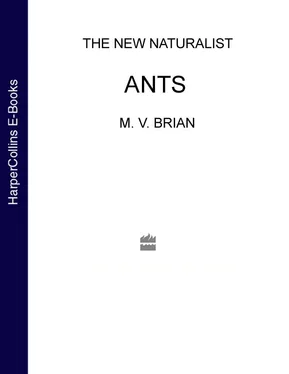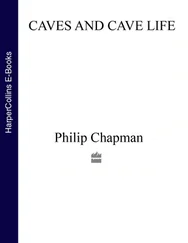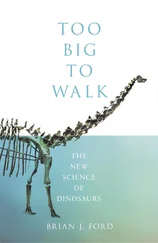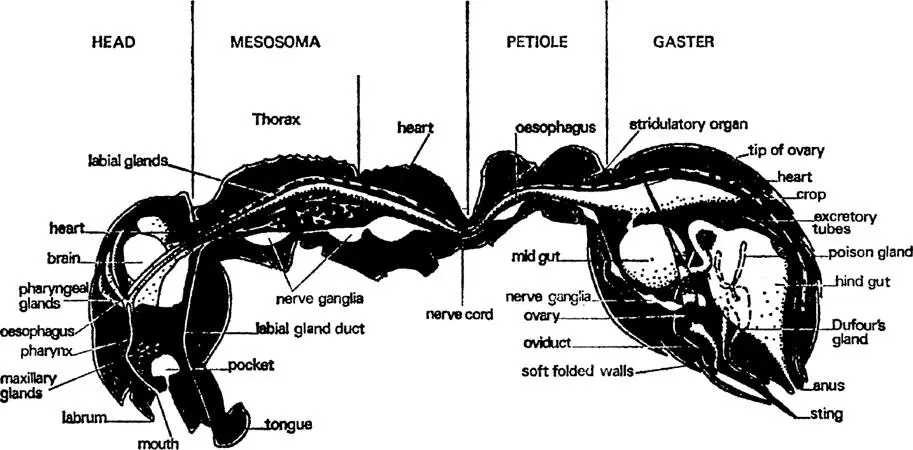
FIG. 1. Worker of Myrmica rubra, sagittal section showing main organs and divisions of the body (after Janet).
A gland opens on each mouth part ( figs. 1, 2, 3). The mandibles have glands that lie against the outer wall of the head, one on each side between the eye and the mandible base. A single layer of cells produces a secretion which is stored in a thin-walled reservoir and conducted by tube to the base of the mandible where it opens through a pore. These glands have several functions: they are partly digestive, partly they lubricate the joints of the mouth and they also contain volatile substances that alert other ants. The maxillary glands have no reservoir and open directly at the base of the maxillae; they probably produce a digestive fluid. The labial glands are not in the head at all; they occur in the front of the mesosoma and are connected to the tip of the tongue by a long, thin tube. They supply a watery lubricant which contains some digestive juices. The most striking gland in the head, next to the mandibular, is the pharyngeal gland; this consists of about twenty finger-shaped tubes, often containing a yellow oil. It is thought that this substance is separated from the food as it travels through the pharynx; it may be digested and used as an energy supply. The watery part of the food goes down the oesophagus to the crop which is in the gaster. From here it can, nevertheless, be regurgitated to larvae and queens and as it contains most of the proteins it is of great value to them, either for body growth or egg production, as the case may be.
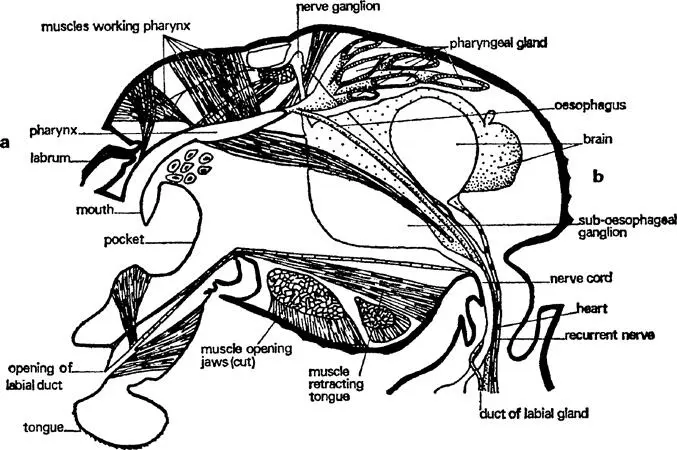
FIG. 2. Worker of Myrmica rubra , head sagittal section showing main organs (after Janet).
In the narrow constriction between the head and the mesosoma there are six channels: the ventral nerve cord, the duct of the labial gland, the oesophagus, two air ducts and the tubular heart. In the mesosoma the ventral nerve cord forms into three ganglia (the last a compound one) that are largely concerned with co-ordinating leg and wing movements. It contains all the muscles operating the legs and, in the sexuals, the wings. In fertile queens these wing muscles degenerate and the material from them is used to make eggs which not only give rise to a brood of larvae but are also used to feed them. Later on, when the colony is well established, the space occupied by the muscles becomes filled with storage tissue called fat-body from the opalescent oil droplets that are the principal component. Muscular action uses a lot of energy and the mesosomal organ must be well-supplied with oxygen from the three pairs of air tubes. There is also a pair of large air sacs which may be ventilated during muscular movement in some way.
FIG. 3. Worker of Myrmica rubra , head section from a. to b. of fig. 2(after Janet).
Water-dissolved substances are carried through the long, thin oesophagus to be stored in a dilatation called the crop which lies dorsally in the front of the gaster. This can be distended to a huge size for it is used to carry nectar and honeydew back to the nest. There is a valve between the crop and the rest of the gut which prevents a good deal of loss from the crop but not all. In some ants this is held closed by muscular sphincters; in others it closes passively when the fluid pressure in the crop rises. It is thought that this second method of control is more efficient since it uses no energy. The crop contents are mostly very liquid and can be regurgitated to other adults and to larvae. This is probably done by telescoping the gastral segments inwards but perhaps by reversing the pharyngeal pump mechanism.
Once fluid has passed back into the midgut it can no longer be shared by other ants. The thick walls of the midgut ( fig. 4) secrete digestive enzymes and absorb the small molecules into which the food is broken. Waste material passes back through another tube into a thin-walled hindgut which stores indigestible residues and probably extracts some water and water-soluble substances. Finally, the liquid waste is ejected in a special part of the nest some way away from the brood rearing zone, along with the refuse. Foragers probably eject their own residues outside the nest. It includes waste substances extracted from the body fluids by long, thin, hollow, thread-like tubules; they join the gut just after the midgut. Much of this excretion is synthesized into uric acid which appears as white granules. In workers the main storage tissue is in the gaster. Oils, glycogen and proteins are all stored there though most of it is oil.
FIG. 4. Queen of Myrmica rubra , gaster sagittal section showing main organs (after Janet).
A very important part of the gaster is occupied by the genital system ( fig. 4). This consists of thin-walled egg tubes (many more in queens than in workers) that start just below the heart at the front of the gaster and pass backwards and downwards to the genital opening below the anus and the sting. Eggs start as small cells at the tip and move down, growing and maturing as they go. Part of the material for growth comes from nurse cells which are broken down and incorporated into the egg tissue but some is extracted from the blood by an enveloping layer of follicle cells. When the egg has been fully formed it is enclosed in a special skin (the chorion) and the egg passes into the oviduct to be fertilized. The oviduct is a simple tube with a thicker wall than the ovary. In queens it has two pouches on its dorsal side, one near the outside which received sperm during copulation and the other a bit farther in that stores the sperm alive for a decade or more. How it gets from one to the other is unknown. These pouches are not present in workers unless the ant is a very primitive species.
It remains only to mention two glands that open into the sting ( fig. 4). One is the poison gland which consists of two closed tubes feeding a thin-walled storage vesicle and which contains a watery solution of mixed venoms. The other is a smaller gland called after Dufour which contains an oily material secreted by cells which surround the storage space. The poison glands vary quite considerably in different families of ant, depending upon whether they synthesize a thin liquid for squirting or injecting with a sting, or a sticky fluid for smearing.
In general the ant body is neatly divided for separate functions: the head carries the main sense organs and the brain and has in front a mechanism for food capture and food pre-treatment, the mesosoma is specialized for locomotion and the gaster has a region of absorption and food storage but also contains the reproductive organs. Defensive apparatus is disposed both in front and behind but the body is flexible enough for both to act forwards in concert.
Ants’ eggs are oval and white; each egg weighs only ·00005 gm and is less than a millimetre long. In most of them a legless grub develops. This is of course no bigger than an egg at first and breaks its way out by means of its sharply pointed jaws. It is almost hairless and transparent so that a small, residual blob of egg yolk in its midgut can easily be seen. Though its cuticle is inelastic rather like polythene it is wrinkled and folded so that a good deal of room for expansion is allowed. There are three stages separated by moults, when the old skin is cast off and a new one, folded and wrinkled to allow for growth, is built underneath. Only the head has a firm cuticle that will not expand at all so that its growth only takes place during the moult between successive stages. The second stage has a good many more hairs than the first and the third and last stage is very hairy indeed. It has some hooked hairs as well as the simple ones which enable the grubs to interlock and so be carried about in one group. It is tempting to believe that the workers are able to distinguish the stages by feeling the degree of hairiness with their antennae, but again this has not been tested by experiment.
Читать дальше
